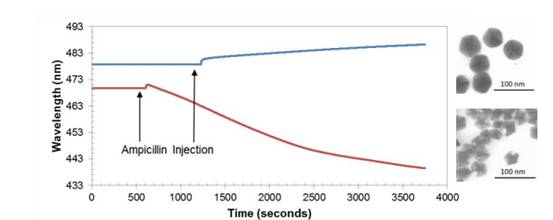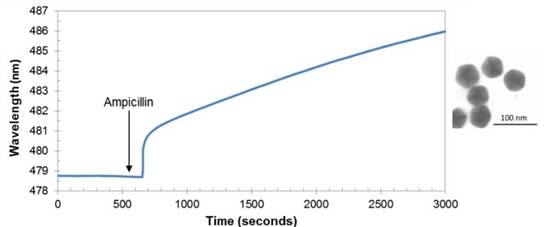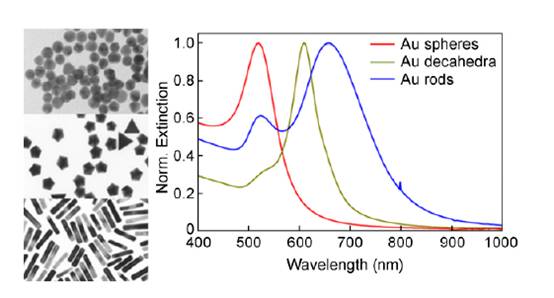Nano-metal particles have unique optical properties. Usually, the metal particles are made of precious metals because they are chemically stable, and gold and silver can excite the LSPR effect in the visible and near-infrared range. These performance characteristics are significant for the development of next-generation biosensors, the evaluation of new synthetic technologies, the exploration of potential physical features, and many other applications. Nicoya Personal Molecular Interaction Instrument is a powerful analytical tool for the application of nano-gold particle plasma. It uses the new patented technology LSPR (US Patent No.: US8693003 B2) to detect the light absorption peak with nano gold particles as carrier. The displacement changes. It further enhances the performance and computational power of the optical platform and enables real-time detection of characteristic peaks of nanoplasma in solution. In general, SPR is a good tool for studying the changes in the plasma absorption peak of nanoparticle plasma tracking surfaces, allowing for a more detailed observation of the characteristics of the nanoparticles. The optical system of LSPR technology is simpler and the cost is greatly reduced. The detection result is comparable to the traditional SPR technology. Since the wavelength change of light is less affected by the environment, the personal molecular interaction instrument is not disturbed by changes in solution volume, ambient temperature, and the like. And because it is perfectly integrated with user-friendly applications, the analyzer automatically acquires data faster and allows for post-processing of minimal spectral data, while still being based on its stable plasma background, compared to traditional spectrophotometers. For accurate analyte detection. The Laurier University-Vladimir Kitaev research team conducted a classic controlled trial in which they applied 1% gold-plated decahedral silver nanoparticles (Au@AgDeNPs) and precursor silver decahedral nanoparticles. (AgDeNPs) A comparative analysis of a series of parameters was performed. As a result, it was found that the plasma change due to ligand binding was consistent with the structural change observed by transmission electron microscopy. Let's reproduce the classic detection application case together: Detection method: Implementation testing: RESULTS: When 10-2M ampicillin (a sulfur-containing antibiotic) was added, Au@AgDeNPs had a significant plasma reaction, and the wavelength change was due to the chemical absorption of sulfur (S) from ampicillin on Au@AgDeNPs gold surface. . The change in the red spectrum is due to the fact that AgDeNPs share electrons with S to reduce the energy required for resonance. The morphological results of Au@AgDeNPs showed partial decomposition or a "snap-like" structure. The AgDeNPs nanoparticles are rounded when exposed to ampicillin. B, the effect of cysteine ​​on Au@AgDeNPs Figure 3. Changes in SPR real-time peaks and transmission electron microscopy images after addition of 10-5 M cysteine ​​to 1% Au@AgDeNPs. RESULTS: Figure 3 shows the SPR real-time maximum response and electron micrograph of Au@AgDeNPs detected after the addition of cysteine. Cysteine ​​(a thiol-containing amino acid) was added, and the plasma effect of the apparent spectral change increased. The change is the result of the surface-ligand interaction of the sulfur on the Au@AgDeNPs gold surface thiol group. This interaction results in a slight etch of the surface morphology of the nanoparticles. In addition, the LSPR phenomenon will exhibit unique and tunable optical properties depending on the type, shape and size of the metal nanoparticles. These properties make the corresponding sensors uniquely advantageous. in conclusion: Nicoya Personal Analyzer Technology Advantages: Contact information: Raw Sunflower Seeds,Plain Sunflower Seeds,Unroasted Sunflower Seeds,Raw Sunflower Wuyuan county dafeng oil food co.,ltd , https://www.sundafengfoods.com
1. Pipette the nano-solution into the micro-absorption cell and record the change in absorption spectrum in real time.
2. Add the test solution to the micro-absorption cell and observe the interaction in real time.
3. Morphological changes of nanoparticles were observed by transmission electron microscopy.
A. The maximum change of SPR was compared with the electron microscope image in real time. 1% Au@AgDeNPs and primary AgDeNPs were added to ampicillin.

Figure 1. Changes in real-time peaks of SPR and TEM images of nanoparticles after addition of 10-2 M ampicillin to 1% Au@AgDeNPs and AgDeNPs 
Figure 2. Real-time maximum response and TEM image of Au@AgDeNPs SPR after addition of 10-2 M ampicillin 
Achieved a noise rate below 20pm.

Fig. 4 Transmission photo spectrum of nano-gold colloids with different geometric shapes
Nicoya's personal molecular interaction instrument OpenSPR uses local surface plasmon resonance technology to quickly detect samples, with simple operation and sensitive and reliable results. It is a good tool for studying the plasma absorption peak of the nanoparticle plasma tracking surface, which enables a more detailed observation of the nanoparticle characteristics.
High performance and low cost - every laboratory has the ability to purchase to meet a variety of experimental needs - 6 different chips are optional and powerful - can be used for protein, nucleic acid, lipid, peptide and other large and small molecular interactions Simple analysis operation----half an hour to control the experiment cost is low-----some chips can be reused without maintenance cost----simple and stable optical system high detection efficiency-----loading, out Results, one-click analysis
Puruimai (Beijing) Laboratory Technology Co., Ltd. Address: International Business Incubation Center, No. 9 Kexing Road, Fengtai District, Beijing Tel: 010-51668388 Fax: 010-83628807-8002
Hotline: 4006-813-863 E-mail:
Website: